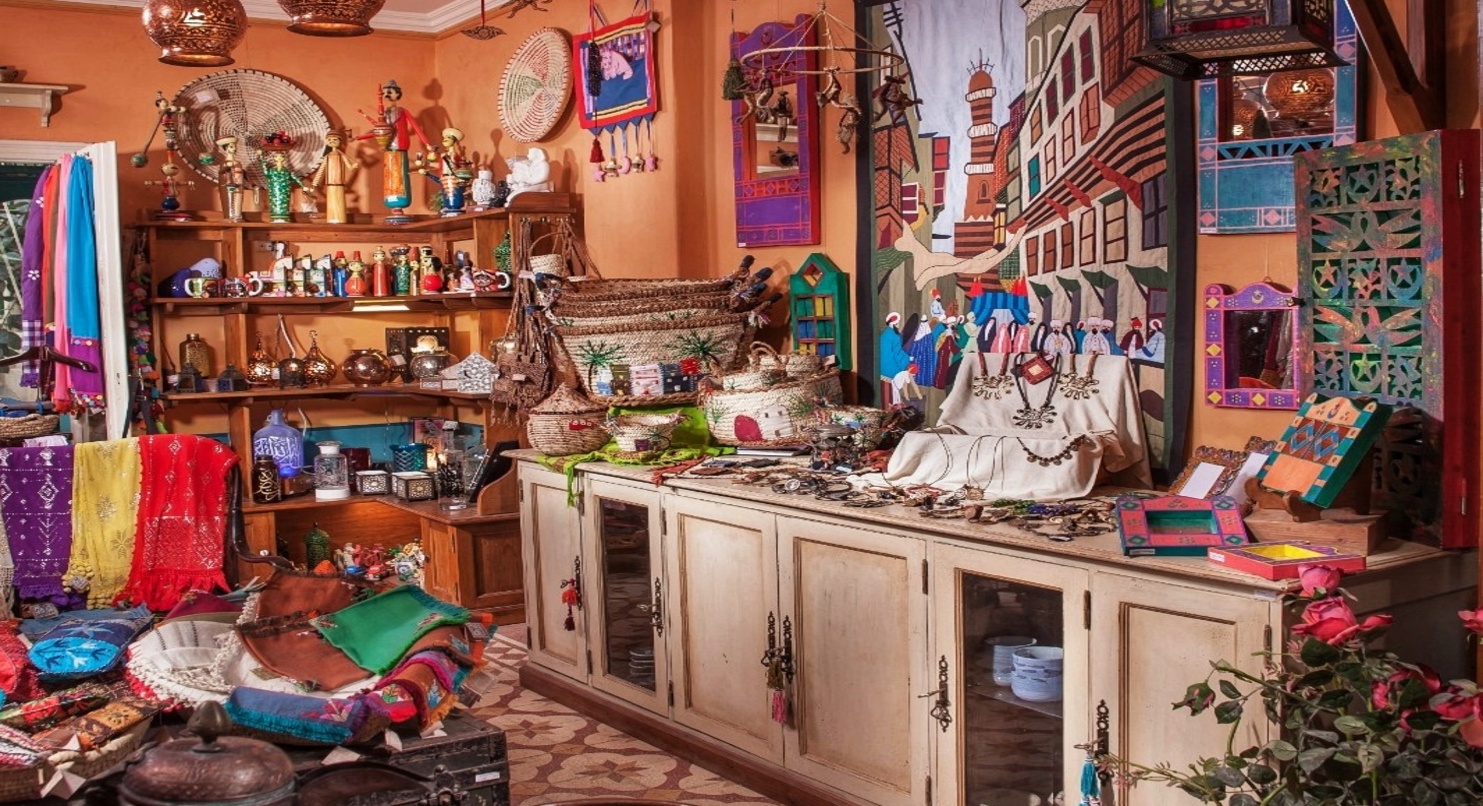Melbalad Gallery of Egyptian Handicrafts is a journey through time and space in search of everything that is authentic about traditional Egyptian handicrafts. Spanning from ancient Egyptian times to the present day, the gallery traverses Egypt, from the Mediterranean to Upper Egypt and from the eastern to the western deserts.
Rehab Mansour, the visionary behind Melbalad – which means ‘from the country’ in Arabic – established the gallery in 2008 after immersing herself in academia for 14 years.
In an interview with Egyptian Streets, Melbalad founder and CEO Mansour shared her inspiration for embarking on this project, as well as the challenges she encounters in uniting the diverse corners of the country within one initiative.
How It All Began
Little did Mansour know back then, but her journey towards founding Melbalad Gallery began in 1993, specifically when she was on a quest for a unique interior design graduation project, seeking a departure from the modern and ultra-modern styles she had been immersed in throughout her studies. While everyone seemed to favor French or English classical art, she took a different path and delved into the realm of Islamic art.
A trip to Cairo followed, where she explored landmarks like Al-Azhar and Al-Ghouri Centre for Heritage Arts. She encountered, for the first time, an abundance of traditional Egyptian art forms, and a newfound appreciation for them began to blossom.
As part of her research, Mansour delved deeper into the world of Egyptian artists and their crafts. She familiarized herself with the inner workings of a handicrafts studio, learning about the machinery and the skilled craftsmen and craftswomen involved. Initially, she was only conducting research for her graduation project and had no plans to start a gallery.
However, her passion for handicrafts remained strong, and she continued to pursue it as a hobby by traveling and collecting unique items, while still working in academia. Eventually, she felt a desire to transition from teaching to becoming a designer. She realized that she had accumulated vast knowledge in the field, extensive connections, and profound understanding of traditional handicrafts, inspiring her to consider the business aspect of her artistic interests.
For four years, Mansour meticulously planned and engaged in discussions with people she had met during her previous explorations, this time with a business mindset. In 2008, her aspirations became a reality when she established Melbalad Gallery.
Reception in Alexandria
Mansour explained that when she first started, people in Alexandria were unaware of the concept and the value of Egyptian traditional artforms and handicrafts. The items she offered are – to this day – distinct from mainstream products, and there was no established consumer demand.
What made it even more difficult was the absence of similar galleries within Alexandria.
“Our type of products needs visibility for there to be demand. In a large market, even if competition arises, it generates necessary product visibility. Cairo is different and has a large number of art galleries and craft shops, offering local artisans a more receptive audience,” explained Mansour.
However, she has now found a level of genuine admiration among customers for the artistry and authenticity found in handmade crafts that she finds remarkable.
“People genuinely admire and support the project. Initially, it takes time for individuals to comprehend and embrace the concept, but gradually, they are starting to recognize the value of local products instead of relying solely on branded and imported goods,” said Mansour.
Among other things, Mansour credits the positive change in preferences to the heightened sense of Egyptian identity following the 2011 revolution. The once-undervalued art of handicrafts experienced a resurgence, as people began to embrace and appreciate their cultural heritage more than ever before.
Collaborating Across Governorates
Melbalad’s business model relies on collaborating with existing workshops and artists across every region of Egypt, which initially required Mansour to travel extensively in order to carefully select the best artists and workshops that aligned with her specific product requirements.
She would personally visit each governorate, identify its traditional crafts, meet skilled artisans, and engage in detailed discussions about the products and materials. Mansour dedicated herself to focusing on the design aspect and ensuring the pieces were unique.
When she first started Melbalad, Mansour took the lead in designing 75 percent of the products. However, she has now transitioned to guiding the artisans in adjusting their designs for functionality and uniqueness, while leaving the artistic element up to them.
“Purely decorative pieces have limited demand, so I strive to strike a balance between artistic expression and functionality in the products offered by the gallery,” said Mansour.
Increased Government Support is Needed
“It’s personally quite demanding. Balancing time, travel, paperwork, and dealing with bureaucracy can be quite challenging,” Mansour expressed when asked about the challenges of managing everything on her own.
“There are numerous administrative hurdles to overcome, and unfortunately, there is no government or official support available. However, my primary focus is to stay connected with all the artists from every region, as they are at the heart of my project,” the Melbalad founder added.
When asked about the government’s efforts, Mansour explained that while the Ministry of Culture has taken some steps to preserve traditional Egyptian arts and crafts, she finds them to be insufficient. She stressed the crucial need for government support to ensure the long-term survival of these crafts.
Mansour expressed concern about the poor condition of workshops and local craft studios, noting that craftsmen are often compelled to leave their craft behind for more profitable jobs like collecting garbage or becoming tuktuk drivers. She strongly believes that immediate action is necessary to save these crafts from disappearing altogether.
“Other countries, such as those in the Maghreb region or in Latin America, have government ministries dedicated to traditional crafts and support systems in place. They have outlets in every city that focus on promoting and preserving their crafts. Egypt has an immense diversity in traditional crafts, and there is a need for more concerted efforts to highlight and protect them,” explained Mansour.
“Talented artisans are not being discovered, and are not being given a professional platform with enough compensation to pass on their skills to future generations,” said Mansour, which resulted in crafts and specialized techniques disappearing over time.
The Diversity of Egyptian Crafts
Egypt’s rich history as the oldest civilization and its strategic location at the crossroads of the ancient world have transformed it into a true “melting pot of arts,” as Mansour describes.
In the north, Mediterranean countries have left their mark, while the western regions bear the cultural influence of Libya and the Amazigh culture. The south showcases the influences of Sudan and other African nations, the east has strong cultural ties with the Hijaz countries, and the northeastern part of Egypt exhibits influences from the Levant, including Palestine and Jordan, with strikingly similar tatreez (traditional cross stitching art) embroidery. Lastly, the Nile Delta, with its fonun reefeya (rural artforms) deeply rooted in ancient Egyptian heritage, remains an underappreciated gem of authentic Egyptian culture.
These diverse influences – both from within Egypt and beyond – can all be found at Melbalad Gallery, where founder Rehab Mansour now welcomes arts students who seek knowledge for their studies or their graduation projects, mirroring her own journey when she first started.
Subscribe to the Egyptian Streets’ weekly newsletter! Catch up on the latest news, arts & culture headlines, exclusive features and more stories that matter, delivered straight to your inbox by clicking here.








Comments (3)
[…] post Melbalad Gallery: a Tribute to Egypt’s Cultural Heritage Through Handicrafts first appeared on Egyptian […]
[…] Source link […]